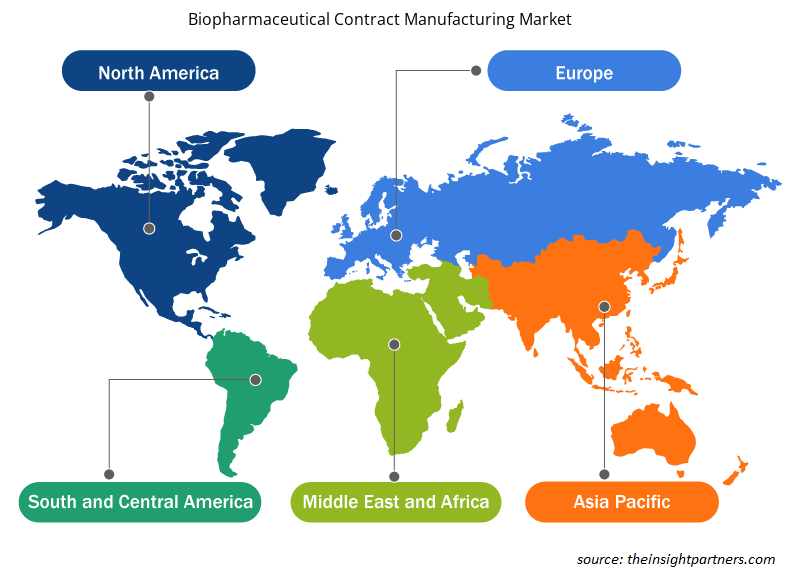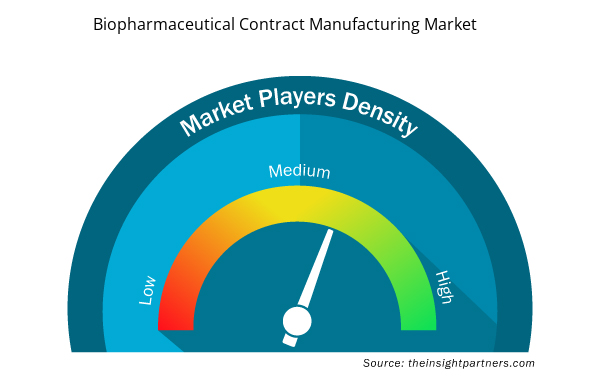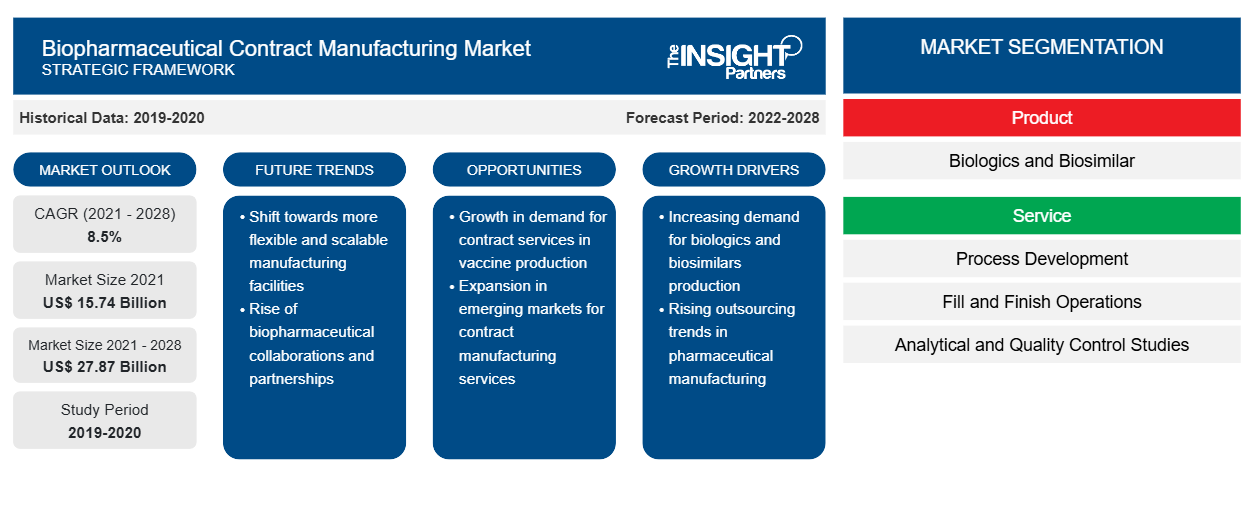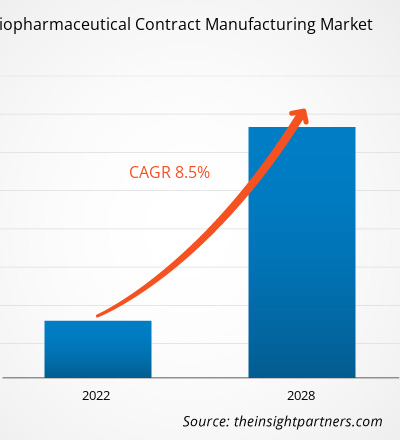[研究报告] 生物制药合同制造市场预计将从 2021 年的 157.3504 亿美元增至 2028 年的 278.685 亿美元;预计 2021 年至 2028 年的复合年增长率为 8.5%。
制药公司外包业务的增加是推动市场增长的最关键因素之一。几年前,合同制造行业是一个利基服务市场,为制药公司提供额外的制造能力或特定服务。CMO 的崛起是由越来越多的药品制造失败所推动的。过去,制药公司已经承担了制造设施来开发创新药物。然而,为了降低产能过剩的风险,对制造外包的需求不断上升。最近,Revolo Biotherapeutics 与合同开发和制造组织 (CDMO) Northway Biotech 建立了合作伙伴关系,以生产 Revolo 的结合免疫调节蛋白 1805。该合作伙伴关系包括从细胞系开发到制造蛋白质的服务,并提供质量保证和法规遵从性支持。同样,Gland Pharma 自 2021 年以来一直在为包括 Mylan 在内的四家公司生产瑞德西韦。此外,由于公司需求旺盛,该组织增加了制造配额。2019 年,Samsung Biologics 和 GI Innovation 签署了免疫化疗合同。根据该协议,三星生物制剂公司将提供从 f 细胞系开发到 I 期药物物质生产的一系列服务。生物制药公司与合同制造公司之间的合同数量不断增加,表明生物制药合同制造市场的规模正在不断扩大。
2021-2028 年,北美很可能继续在生物制药合同制造市场占据主导地位。美国在北美占有最大的市场份额,预计在预测期内将继续保持这一趋势。临床试验需求的增加、制药和医疗器械行业的增长、医疗保健支出的增加、高研发支出以及该地区提供制造、仓储、物流和其他服务的主要市场参与者的存在可能会促进该国的市场增长。例如,Alderley Analytical、Almac 等是知名的制造组织,为 600 多家制药和生物技术公司提供广泛的综合服务。生物制药公司在该地区的收入、技术和就业机会方面的存在和重大影响预计将有助于该地区市场的增长。
定制此报告以满足您的需求
您可以免费定制任何报告,包括本报告的部分内容、国家级分析、Excel 数据包,以及为初创企业和大学提供优惠和折扣
- 获取此报告的关键市场趋势。这个免费样品将包括数据分析,从市场趋势到估计和预测。
市场洞察
生物制剂需求增长推动市场增长
由于生物制剂产品线不断增加、制造复杂性增加以及公司将重点转向核心活动,生物制剂的合同制造市场正以前所未有的速度增长。目前,许多制药和生物技术公司将各种服务外包,从早期药物开发到商业规模制造。外包是加快研发、加快市场进入、获得新技术和监管专业知识以及以有竞争力的成本降低风险所必需的。生物制剂开发和生产的复杂性以及日益严格的质量标准促使药品制造商更倾向于合同制造服务。此外,许多公司选择 CMO 服务来加快开发过程并降低生产成本。例如,赛诺菲已将其生物制剂产品线的制造外包给勃林格殷格翰。此外,TaiMed Biologics Ibalizumab(FDA 指定的孤儿药)由 CMO 无锡药明康德生产。此外,2021年,三星生物制剂公司从2020年开始扩大与阿斯利康的合作,包括生产一种药物——阿斯利康的COVID-19长效抗体组合,以及从2022年开始制造一种癌症免疫治疗产品。
基于产品的见解
根据产品,生物制药合同制造市场细分为生物仿制药和生物制剂。由于预测期内对生物制剂的需求不断增加,研发活动不断增加,以开发用于治疗慢性疾病的新药,生物制剂部门在 2021 年占据了最大的市场份额。该部门进一步细分为单克隆抗体、重组蛋白、疫苗等。由于重磅药物的专利到期和产品线不断增加,生物仿制药市场预计将在预测期内实现最高的复合年增长率。
服务洞察
生物制药合同制造市场按服务细分为工艺开发、灌装和完成操作、分析和质量控制研究以及包装。2021 年,工艺开发在全球生物制药合同制造市场中占据最大市场份额,因为该市场更注重从试点到商业化扩大规模的工艺开发、细胞系开发和其他工艺。然而,由于严格的监管规定和生物制剂复杂的制造要求,预计分析和质量控制研究在预测期内将以显着的复合年增长率增长。
生物制药合同制造市场中的公司采用产品创新战略来满足全球不断变化的客户需求,这也使他们能够在全球市场上保持自己的品牌名称。此外,市场中的公司与生物制药公司建立合作伙伴关系、合作关系和合同,以进一步推动市场的收入。
生物制药合同制造市场 – 细分
根据产品,生物制药合同制造市场分为生物制剂和生物仿制药。生物制剂部分进一步细分为单克隆抗体、重组蛋白、疫苗和其他。
根据服务,生物制药合同制造市场分为工艺开发、灌装和完成操作、分析和质量控制研究以及包装。
根据来源,生物制药合同制造市场分为哺乳动物和基于微生物的生物制剂/非哺乳动物。
生物制药合同制造市场区域洞察
Insight Partners 的分析师已详尽解释了预测期内影响生物制药合同制造市场的区域趋势和因素。本节还讨论了北美、欧洲、亚太地区、中东和非洲以及南美和中美洲的生物制药合同制造市场细分和地理位置。

- 获取生物制药合同制造市场的区域特定数据
生物制药合同制造市场报告范围
| 报告属性 | 细节 |
|---|---|
| 2021 年市场规模 | 157.4亿美元 |
| 2028 年市场规模 | 278.7亿美元 |
| 全球复合年增长率(2021 - 2028) | 8.5% |
| 史料 | 2019-2020 |
| 预测期 | 2022-2028 |
| 涵盖的领域 | 按产品
|
| 覆盖地区和国家 | 北美
|
| 市场领导者和主要公司简介 |
|
生物制药合同制造市场参与者密度:了解其对业务动态的影响
生物制药合同制造市场正在快速增长,这得益于最终用户需求的不断增长,而这些需求又源于消费者偏好的不断变化、技术进步以及对产品优势的认识不断提高等因素。随着需求的增加,企业正在扩大其产品范围,进行创新以满足消费者的需求,并利用新兴趋势,从而进一步推动市场增长。
市场参与者密度是指在特定市场或行业内运营的企业或公司的分布情况。它表明在给定市场空间中,相对于其规模或总市场价值,有多少竞争对手(市场参与者)存在。
在生物制药合同制造市场运营的主要公司有:
- 龙沙公司
- 勃林格殷格翰生物制药有限公司
- Inno Bio Ventures 私人有限公司
- 赛默飞世尔科技公司
- 艾伯维(AbbVie)公司
免责声明:上面列出的公司没有按照任何特定顺序排列。

- 了解生物制药合同制造市场的主要参与者概况
生物制药合同制造市场 – 按地区划分
根据地域划分,生物制药合同管理市场主要分为北美、欧洲、亚太、中东和非洲以及南美洲和中美洲。北美市场进一步细分为美国、加拿大和墨西哥。欧洲生物制药合同管理市场细分为德国、法国、英国、西班牙、意大利和欧洲其他地区。亚太市场细分为中国、印度、日本、澳大利亚、韩国和亚太其他地区。中东和非洲生物制药合同管理市场进一步细分为沙特阿拉伯、阿联酋、南非和中东和非洲其他地区。南美洲和中美洲市场细分为巴西、阿根廷和南美洲和中美洲其他地区。
公司简介
- 龙沙公司
- 勃林格殷格翰生物制药有限公司
- Inno Bio Ventures 私人有限公司
- 赛默飞世尔科技公司
- 艾伯维(AbbVie)公司
- 药明生物科技股份有限公司
- 通用电气公司
- 三星生物制剂有限公司
- 默克公司
- 味之素株式会社
- 历史分析(2 年)、基准年、预测(7 年)及复合年增长率
- PEST 和 SWOT 分析
- 市场规模价值/数量 - 全球、区域、国家
- 行业和竞争格局
- Excel 数据集



Report Coverage
Revenue forecast, Company Analysis, Industry landscape, Growth factors, and Trends

Segment Covered
This text is related
to segments covered.

Regional Scope
North America, Europe, Asia Pacific, Middle East & Africa, South & Central America

Country Scope
This text is related
to country scope.
常见问题
The biopharmaceutical contract manufacturing market majorly consists of the players such as Lonza AG, Boehringer Ingelheim Biopharmaceuticals GmbH, Inno Bio Ventures Sdn Bhd, Thermo Fisher Scientific, Inc., AbbVie, Inc., WuXi Biologics, Inc., General Electric Co., Samsung Biologics Co. Ltd., Merck KGaA, and Ajinomoto Co. Inc., among others.
The factors that are driving the growth of the market are increasing demand for biologics, growing biosimilar pipelines, stringent regulatory guidelines, and increasing outsourcing by pharmaceutical companies. Moreover, emerging markets are offering lucrative opportunities owing to the increasing number of contract manufacturers in developing countries.
Biopharmaceuticals contract manufacturing refers to biopharmaceutical companies outsourcing the development and manufacturing of drugs substances and products to contract manufacturers with the necessary resources to manufacture their products. Biopharmaceutical contract manufacturing organizations (CMOs) have become a known name among pharmaceutical companies due to their cost effective services that require minimal capital investments by the biopharmaceutical company. The CMOs offer a wide range of services including process development, analytical and quality control studies, fill and finish operations, and packaging. Moreover, the growing biopharma industry is offering lucrative opportunities for the growth of the market.
Trends and growth analysis reports related to Life Sciences : READ MORE..
The List of Companies - Biopharmaceuticals Contract Manufacturing Market
- Lonza AG
- Boehringer Ingelheim Biopharmaceuticals GmbH
- Inno Bio Ventures Sdn Bhd
- Thermo Fisher Scientific, Inc.
- AbbVie, Inc.
- WuXi Biologics, Inc.
- General Electric Co.
- Samsung Biologics Co. Ltd.
- Merck KGaA
- Ajinomoto Co. Inc.
The Insight Partners performs research in 4 major stages: Data Collection & Secondary Research, Primary Research, Data Analysis and Data Triangulation & Final Review.
- Data Collection and Secondary Research:
As a market research and consulting firm operating from a decade, we have published and advised several client across the globe. First step for any study will start with an assessment of currently available data and insights from existing reports. Further, historical and current market information is collected from Investor Presentations, Annual Reports, SEC Filings, etc., and other information related to company’s performance and market positioning are gathered from Paid Databases (Factiva, Hoovers, and Reuters) and various other publications available in public domain.
Several associations trade associates, technical forums, institutes, societies and organization are accessed to gain technical as well as market related insights through their publications such as research papers, blogs and press releases related to the studies are referred to get cues about the market. Further, white papers, journals, magazines, and other news articles published in last 3 years are scrutinized and analyzed to understand the current market trends.
- Primary Research:
The primarily interview analysis comprise of data obtained from industry participants interview and answers to survey questions gathered by in-house primary team.
For primary research, interviews are conducted with industry experts/CEOs/Marketing Managers/VPs/Subject Matter Experts from both demand and supply side to get a 360-degree view of the market. The primary team conducts several interviews based on the complexity of the markets to understand the various market trends and dynamics which makes research more credible and precise.
A typical research interview fulfils the following functions:
- Provides first-hand information on the market size, market trends, growth trends, competitive landscape, and outlook
- Validates and strengthens in-house secondary research findings
- Develops the analysis team’s expertise and market understanding
Primary research involves email interactions and telephone interviews for each market, category, segment, and sub-segment across geographies. The participants who typically take part in such a process include, but are not limited to:
- Industry participants: VPs, business development managers, market intelligence managers and national sales managers
- Outside experts: Valuation experts, research analysts and key opinion leaders specializing in the electronics and semiconductor industry.
Below is the breakup of our primary respondents by company, designation, and region:

Once we receive the confirmation from primary research sources or primary respondents, we finalize the base year market estimation and forecast the data as per the macroeconomic and microeconomic factors assessed during data collection.
- Data Analysis:
Once data is validated through both secondary as well as primary respondents, we finalize the market estimations by hypothesis formulation and factor analysis at regional and country level.
- Macro-Economic Factor Analysis:
We analyse macroeconomic indicators such the gross domestic product (GDP), increase in the demand for goods and services across industries, technological advancement, regional economic growth, governmental policies, the influence of COVID-19, PEST analysis, and other aspects. This analysis aids in setting benchmarks for various nations/regions and approximating market splits. Additionally, the general trend of the aforementioned components aid in determining the market's development possibilities.
- Country Level Data:
Various factors that are especially aligned to the country are taken into account to determine the market size for a certain area and country, including the presence of vendors, such as headquarters and offices, the country's GDP, demand patterns, and industry growth. To comprehend the market dynamics for the nation, a number of growth variables, inhibitors, application areas, and current market trends are researched. The aforementioned elements aid in determining the country's overall market's growth potential.
- Company Profile:
The “Table of Contents” is formulated by listing and analyzing more than 25 - 30 companies operating in the market ecosystem across geographies. However, we profile only 10 companies as a standard practice in our syndicate reports. These 10 companies comprise leading, emerging, and regional players. Nonetheless, our analysis is not restricted to the 10 listed companies, we also analyze other companies present in the market to develop a holistic view and understand the prevailing trends. The “Company Profiles” section in the report covers key facts, business description, products & services, financial information, SWOT analysis, and key developments. The financial information presented is extracted from the annual reports and official documents of the publicly listed companies. Upon collecting the information for the sections of respective companies, we verify them via various primary sources and then compile the data in respective company profiles. The company level information helps us in deriving the base number as well as in forecasting the market size.
- Developing Base Number:
Aggregation of sales statistics (2020-2022) and macro-economic factor, and other secondary and primary research insights are utilized to arrive at base number and related market shares for 2022. The data gaps are identified in this step and relevant market data is analyzed, collected from paid primary interviews or databases. On finalizing the base year market size, forecasts are developed on the basis of macro-economic, industry and market growth factors and company level analysis.
- Data Triangulation and Final Review:
The market findings and base year market size calculations are validated from supply as well as demand side. Demand side validations are based on macro-economic factor analysis and benchmarks for respective regions and countries. In case of supply side validations, revenues of major companies are estimated (in case not available) based on industry benchmark, approximate number of employees, product portfolio, and primary interviews revenues are gathered. Further revenue from target product/service segment is assessed to avoid overshooting of market statistics. In case of heavy deviations between supply and demand side values, all thes steps are repeated to achieve synchronization.
We follow an iterative model, wherein we share our research findings with Subject Matter Experts (SME’s) and Key Opinion Leaders (KOLs) until consensus view of the market is not formulated – this model negates any drastic deviation in the opinions of experts. Only validated and universally acceptable research findings are quoted in our reports.
We have important check points that we use to validate our research findings – which we call – data triangulation, where we validate the information, we generate from secondary sources with primary interviews and then we re-validate with our internal data bases and Subject matter experts. This comprehensive model enables us to deliver high quality, reliable data in shortest possible time.


 获取此报告的免费样本
获取此报告的免费样本